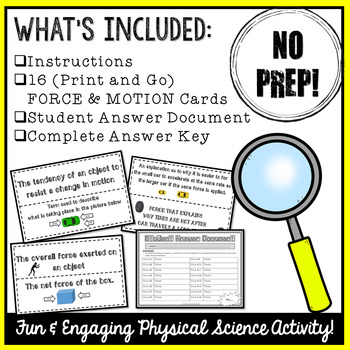Force & Motion Scavenger Hunt Activity [Print & Digital for Distance Learning]
- Zip
- Google Apps™

What educators are saying
Description
Provide engaging instruction and reinforce physics skills with this Force and Motion SCAVENGER HUNT. Keep the activity in your classroom or make it a school wide search! Either way, this scavenger hunt is sure to engage and motivate ALL of your students (grades 6-12).
This Force and Motion Scavenger Hunt is ready to use- just print, fold and hang! I like to post the clues around my classroom and in the hallway, but have also made this a school-wide activity for more of a challenge. My students love to participate in this scavenger hunt as a review before the test! The competition/race proves to be a sure way to engage my students.
***NEWLY ADDED: I have included a digital version of this scavenger hunt that is presented as a link that will take you to a Google Slides document.
What's Included:
⭐ 16 Print & Go Clues
⭐Student Answer Document
⭐Teacher Answer Key
⭐Teacher Instructions/Set-Up
⭐Digital Version (Google Slides)
★★★Skills covered in this activity include: motion graphs, speed/velocity, acceleration, Newton's 1st, 2nd & 3rd law, inertia, force, mass, friction, gravity, weight, balanced forces, unbalanced forces, and net force.★★★
⭐You might also like these other Force and Motion resources...
★THE CASE OF THE MURDERED MASCOT: ACCELERATION CSI ACTIVITY
★FORCE & MOTION 5-E STEM PROJECT
★Bundle and SAVE 20% with my Force & Motion MEGA Bundle! All of the work has been done for you with this 6-8 week, all-inclusive unit bundle!
Join our Physical Science Teacher Tribe on Facebook for ideas, resources, inspiration and More! Click HERE to join!
Connect with me:
❤️Newsletter ❤️Blog ❤️Facebook ❤️Instagram ❤️Pinterest
TPT Customer Tips:
How to get TPT credit to use on future purchases: *Please go to your My Purchases page (you may need to login). Beside each purchase you'll see a Provide Feedback button. Simply click it and you will be taken to a page where you can give a quick rating and leave a short comment for the product. Each time you give feedback, TPT gives you feedback credits that you use to lower the cost of your future purchases. Feedback and ratings are most greatly appreciated. Be the first to know about my sales, discounts, freebies and new products: *Look for the green star next to my store logo (THE TRENDY SCIENCE TEACHER) and click it to become a follower. That's it! You will now receive email updates about this store.





